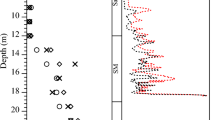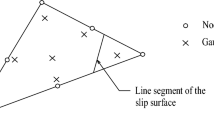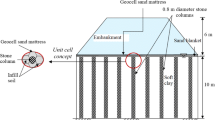Abstract
The focus of this study was to evaluate the behaviour of a test embankment supported on vibro stone columns (VSCs) installed with a low area replacement ratio (7.56%) based on data obtained from field instrumentation complemented by analytical and numerical methods. The test embankment is 5.35 m high and was built on top of a soft soil treated with VSCs arranged in a 10-column × 10-column square grid. Analytical and two-dimensional finite element methods using the axisymmetric unit cell approach were also employed in the study to analyse the instrumentation data. The measured settlement-time curves, for the embankment axis, were compatible with finite element analysis in which the coefficient of permeability was continuously updated with the void ratio. Comparison was also favourable regarding measured and predicted values of settlements and improvement factors. All evidence indicates that VSCs installed with a low area replacement ratio (<10%) were quite effective in reducing the time for settlement stabilization and in providing adequate short-term stability against failure, but less effective in reducing the long-term settlement magnitude.
Similar content being viewed by others
Abbreviations
- A :
-
Unit cell area (m2)
- A c :
-
Area of granular column (m2)
- ARR:
-
Area replacement ratio (%)
- a v :
-
Coefficient of compressibility (kPa−1)
- c′:
-
Effective cohesion (kPa)
- C c :
-
Compression index [-]
- c h :
-
Coefficient of horizontal consolidation (m2/day)
- C K :
-
Relationship between permeability and void ratio [-]
- C s :
-
Swelling index [-]
- c v :
-
Coefficient of vertical consolidation (m2/day)
- c v(ave):
-
Average coefficient of vertical consolidation (m2/day)
- C α :
-
Coefficient of secondary compression [-]
- d c :
-
Diameter of granular column (m)
- d e :
-
Equivalent diameter of the unit cell (m)
- D 50 :
-
Diameter in which 50% in mass are smaller than the diameter d50 [-]
- E :
-
Elastic modulus of materials (MPa)
- e 0 :
-
Initial void ratio [-]
- FEM/FEA/FE:
-
Finite elements method/analysis [-]
- H emb :
-
h = Embankment height (m)
- h crit :
-
Critical embankment height (m)
- IF:
-
Improvement factor [-]
- K*:
-
Coefficient of earth pressure of the soft soil adjacent to the VSC [-]
- K a :
-
Active coefficient of earth pressure
- k h :
-
Coefficient of horizontal permeability (m/day)
- k v :
-
Coefficient of vertical permeability (m/day)
- k vo :
-
Initial coefficient of vertical permeability (m/day)
- K 0 :
-
Coefficient of earth pressure at rest [-]
- L c :
-
Column length (m)
- n 0 :
-
Improvement factor [-]
- n 1 :
-
Improvement factor [-]
- n 2 :
-
Improvement factor [-]
- OCR:
-
Over consolidation ratio [-]
- S :
-
Centre-to-centre spacing of granular column (m)
- S u :
-
Undrained shear strength (kPa)
- t 95% :
-
Time for 95% of consolidation (years)
- T :
-
Mobilized tension in the basal reinforcement
- VSC:
-
Vibro stone columns [-]
- YP:
-
Yield stress point [-]
- γ′:
-
Submerged unit weight (kN/m3)
- γ :
-
Unit weight (kN/m3)
- γ emb :
-
Embankment unit weight (kN/m3)
- γ w :
-
Unit weight of water (kN/m3)
- ∆e :
-
Variation of the void ratio [-]
- ∆h :
-
Settlement of the untreated clay bed (m)
- ∆h c :
-
Settlement of the treated clay bed with VSC (m)
- \(\sigma _v^\prime \) :
-
Effective vertical stress (kPa)
- v :
-
Poisson’s ratio [-]
- φ’ :
-
Effective friction angle (°)
- ψ :
-
Dilatancy angle (°)
References
ABNT NBR 7211:2009 (2009) Aggregates for concrete — Specification. ABNT NBR 7211:2009, Brazilian Association of Technical Standards
ABNT NBR 9820:1997 (1997) Assessment of undisturbed low consistency solid samples from boreholes — Procedure. ABNT NBR 9820:1997, Brazilian Association of Technical Standards
Almeida MSS, Britto AM, Parry RHG (1986) Numerical analysis of stage constructed embankments on soft clays. Canadian Geotechnical Journal 23:103–114
Almeida MSS, Davies MCR, Parry RHG (1985) Centrifuge tests of embankments on strengthened and unstrengthened clay foundations. Géotechnique 35(4):425–441, DOI: https://doi.org/10.1680/geot.1985.35.4.425
Almeida MSS, Futai MM, Lacerda WA, Marques MES (2008) Laboratory behaviour of rio de janeiro soft clays — Part 1: Index and compression properties. Soils & Rocks 31(1):69–75
Almeida MSS, Hosseinpour I, Riccio MVF (2013) Performance of a geosynthetic-encased columns (GEC) in soft ground: Numerical and analytical studies. Geosynthetics International 20(4):252–262, DOI: https://doi.org/10.1680/gein.13.00015
Almeida MSS, Hosseinpour I, Riccio MVF, Alexiew D (2014a) Behavior of geotextile-encased granular columns supporting test embankment on soft deposit. Journal of Geotechnical and Geoenvironmental Engineering 141:04014116–04014116-9, DOI: https://doi.org/10.1061/(ASCE)GT.1943-5606.0001256
Almeida MSS, Lima BT, Riccio MVF, Jud H, Almeida MCF, Roza F (2014b) Stone columns field test: Monitoring data and numerical analyses. Geotechnical Engineering Journal of the SEAGS & AGSSEA 45(1):103–112
Almeida MSS, Marques MES (2013) Design and performance of embankments on very soft soils. CRC Press, Boca Raton, FL, USA
Almeida MSS, Riccio MVF, Hosseinpour I, Alexiew D (2018) Geosynthetic encased columns for soft soil improvement. CRC Press, Taylor & Francis Group, Abingdon, UK
Andreou P, Papadopoulos V (2014) Factors affecting the settlement estimation of the column reinforced soils. Geotechnical Geological Engineering 32:1175–1185, DOI: https://doi.org/10.1007/s10706-014-9788-x
Asaoka A (1978) Observational procedure of settlement prediction. Soils and Foundations 18(4):87–101
Badanagki M, Dashti S, Kirkwood P (2018) Influence of dense granular columns on the performance of level and gently sloping liquefiable sites. Journal of Geotechnical and Geoenvironmental Engineering 144(9):04018065, DOI: https://doi.org/10.1061/(ASCE)GT.1943-5606.0001937
Barron RA (1948) Consolidation of fine-grained soils by drain wells. Journal of the Soil Mechanics and Foundation Division 73(6):811–835
Bjerrum L (1973) Problems of soil mechanics and construction on soft clays and structurally unstable soils (collapsible, expansive and others). 8th ICSMFE, Moscow, Russia, 111–159
Black JA, Sivakumar V, Bell A (2011) The settlement performance of stone column foundations. Géotechnique 61(11):909–922, DOI: https://doi.org/10.1680/GEOT.9.P.014
Bouassida M, Ellouze S (2018) Optimized design of foundation on soil reinforced by floating columns. IPA News Letter 3(3), DOI: https://doi.org/10.1002/cepa.667
Brinkgreve RBJ, Vermeer PA (2002) PLAXIS (version 8): User’s manual. Delft University of Technology and PLAXIS B.V., Delft, Netherlands
Castro J, Sagaseta C (2009) Field instrumentation of an embankment on stone columns. In: Hamza M, Shahien M, El-Mossallamy Y (eds) Proceedings of the 17th international conference on soil mechanics and geotechnical engineering. IOS Press, Alexandria, Egypt, 1865–1868
Dawson K, Shin S (2012) A case history on design, construction, and performance of stone column ground improvement beneath an MSE embankment. In 37th annual conference on deep foundations, October 16–19, Houston, TX, USA
Fattah M, Shlash K, Al-Waily M (2011) Stress concentration ratio of model stone columns in soft clays. Geotechnical Testing Journal 34(1):50–60, DOI: https://doi.org/10.1520/GTJ103060
FHWA (1983) Design and construction of stone columns. Report FHWA/RD-83/027, Federal Highway Administration, Washington DC, USA
Futai MM, Almeida MSS, Lacerda WA (2008) Laboratory behaviour of rio de janeiro soft clays — Part 2: Strength and yield. Soils & Rocks 31(1):77–84
Gebrenegus T, Nicks JE, Adams MT (2015) Large diameter triaxial testing of AASHTO open graded aggregates and the effect of relative density on strength. IFCEE 2015, March 17–21, San Antonio, TX, USA
Han J, Ye SL (2002) A theoretical solution for consolidation rates of stone column reinforced foundations accounting for smear and well resistance effects. International Journal of Geomechanics 2(2):135–151, DOI: https://doi.org/10.1061/(ASCE)1532-3641(2002)2:2(135)
Indraratna B, Ngo NT, Rujikiatkamjorn C, Sloan SW (2015) Coupled discrete element — Finite difference method for analysing the load-deformation behaviour of a single stone column in soft soil. Computers and Geotechnics 63:267–278
Keller Holding GmbH (2013) Annual report and accounts. Keller Holding GmbH, Offenbach, Germany
Kempfert HG (2003) Ground improvement methods with special emphasis on column-type techniques. In: International workshop on geotechnics of soft soils theory and practice. Noordwijkerhout, Netherlands, 101–112
Ladd CC, DeGroot DJ (2003) Recommended practice for soft ground site characterization: Casagrande lecture. 12th Panamerican conference of soil mechanics, Boston, MA, USA
Lima BT (2012) Study of the use of stone columns in very soft clayey soils. PhD Thesis, COPPE-UFRJ, Rio de Janeiro, Brazil (in Portuguese)
Lima BT, Almeida MSS, Hosseinpour I (2019) Field measured and simulated performance of a stone columns-strengthened soft clay deposit. International Journal of Geotechnical Engineering 1–10, DOI: https://doi.org/10.1080/19386362.2019.1653506
Lunne T, Robertson PK, Powell JJM (1997) Cone penetration testing in geotechnical practice. CRC Press, Boca Raton, FL, USA
McCabe BA, Nimmons GJ, Egan D (2009) A review of field performance of stone columns in soft soils. Geotechnical Engineering 162(6): 323–334, DOI: https://doi.org/10.1680/geng.2009.162.6.323
Mesri G, Castro A (1987) Cα/Cc concept and K during secondary compression. Journal of Geotechnical Engineering 113(3):230–247, DOI: https://doi.org/10.1061/(ASCE)0733-9410(1987)113:3(230)
Miranda M, Da Costa A, Castro J, Sagaseta C (2015) Influence of gravel density in the behaviour of soft soils improved with stone columns. Canadian Geotechnical Journal 52(12):1968–1980, DOI: https://doi.org/10.1139/cgj-2014-0487
Priebe HJ (1995) The design of vibro replacement. Ground Engineering 28(12):31–37
Rowe RK, Soderman KL (1985) An approximate method for estimating the stability of geotextile embankments. Canadian Geotechnical Journal 22(3):392–398
Six V, Mroueh H, Shahrour I, Bouassida M (2012) Numerical analysis of elastoplastic behavior of stone column foundation. Geotechnical and Geological Engineering 30(4):813–825, DOI: https://doi.org/10.1007/s10706-012-9500-y
Terzaghi K (1943) Theoretical soil mechanics. Wiley, New York, NY, USA
Weber TM, Plötze M, Laue J, Peschke G, Springman SM (2010) Smear zone identification and soil properties around stone columns constructed in-flight in centrifuge model tests. Géotechnique 60(3):197–206, DOI: https://doi.org/10.1680/geot.8.P.098
Wood DM, Hu W, Nash DFT (2000) Group effects in stone column foundations: Model tests. Géotechnique 50(6):689–698, DOI: https://doi.org/10.1680/geot.2000.50.6.689
Acknowledgments
The present study was financed in part by the Brazilian governing agencies CAPES and CNPq and by the State Agencies FAPERJ (Rio de Janeiro) and FAPEMIG (Minas Gerais). The authors would like to thank the Rio de Janeiro State Environmental Sanitation Program of the Guanabara Bay (PSAM) for its support.
Author information
Authors and Affiliations
Corresponding author
Rights and permissions
About this article
Cite this article
Riccio F., M.V., Almeida, M.S.S., Vasconcelos, S.M. et al. Embankment Supported by Low Area Replacement Ratio Stone Columns, Monitoring and Numerical Studies. KSCE J Civ Eng 26, 619–629 (2022). https://doi.org/10.1007/s12205-021-0540-9
Received:
Revised:
Accepted:
Published:
Issue Date:
DOI: https://doi.org/10.1007/s12205-021-0540-9




